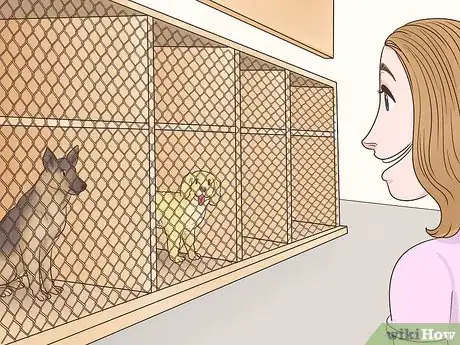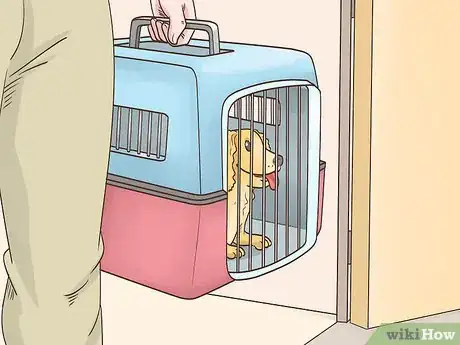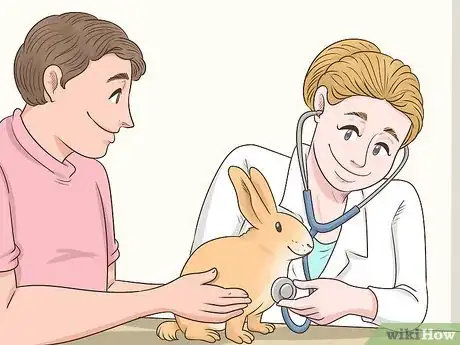This article was co-authored by Nicole Larocco-Skeehan. Nicole Larocco-Skeehan is a Dog Trainer and the Owner of Philly Unleashed in Philadelphia, Pennsylvania. Nicole has over 25 years of experience working with animals and currently specializes in group and private dog training and behavior modification. Nicole’s business has been named the "Best of Philadelphia" and she is the author of “The Teaching Dog: Partnering with Dogs for Instruction, Socialization, and Demonstration in Your Training Practice.” She was also on the Certification Council for Professional Dog Trainers Board of Directors. Nicole holds a Bachelor of Science in Marketing and Advertising from Robert Morris University.
There are 7 references cited in this article, which can be found at the bottom of the page.
This article has been viewed 81,015 times.
If you have decided you want a pet, you can go to a shelter for pet adoption. Adopting a pet from a shelter may save an animal's life in addition to enhancing your life. Animal shelters assess the animals that come in to determine their temperament and health status, and they will make every effort to match you with the right pet. Going through the adoption process at a shelter can be a rewarding experience and it will lead to the exciting adventure of having a new pet.[1]
Steps
Picking Out a Pet
-
1Decide what type of pet you want. Would you like a pet to take on walks? Do you want a guard animal, or a pet that will sit in your lap and cuddle? All of your desires should be considered when thinking about what type of pet to get.
- Some types of pets you could consider include: dogs, cats, rabbits, and birds, such as parakeets and cockatiels.
- When thinking about what type of pet to get, you can be as specific or general as is necessary. It may be that you figure out that you want a dog but you are OK with a wide variety of breeds. On the other hand, it may be that you want a very specific breed and you need it to be a certain age as well.
-
2Separation anxiety. It’s quite common to see separation anxiety in shelter dogs. Still, not all shelter dogs need to suffer from separation anxiety. If you like a dog who seems to have separation anxiety, then don’t give up on him/her, It’s just a behavioral challenge that you can easily overcome. Even though separation anxiety sounds like a big mental disease, but it’s something that you can easily defeat with love, affection, and the most crucial ingredient of all, i.e., trust.
- Separation anxiety is just a state of the mind that the dog develops because of some bad past experiences because of which the dog develops a fear of being abandoned every time it’s left alone and starts to panic.
- If you are concerned about your dog barking when left alone, you can consider contacting a friend or neighbor to see if they can check in on your dog during the day. [2]
Advertisement -
3Take your entire family along with you. Since you are planning to add a new family member, it’s imperative to take your whole family with you to the adoption center, especially if you have kids in your family because there may be instances where a dog can be super cute and friendly around adults. Still, it may show signs of aggression around kids because of some bad past experiences with kids.
- If you already have a dog or any other pet, then try to take it along with you to the adoption center, that way you can ensure that the new family member gets along with all your family members.
- Many animal shelters allow other animals in your household to come and greet the new (possible) addition. In fact, in California, it is highly recommended that this happens so that there is a lesser chance of an animal being returned. [3]
-
4Talk to a pet counselor. Depending on the size of the shelter in your area, you may be able to make an appointment to talk to a pet counselor there. Bring a list of your desires for a pet with you. A pet counselor can guide you in selecting the right type and breed of animal to best meet your needs.
- Not all shelters will have a designated pet counselor. However, many shelter employees are good at discussing the needs of specific pets and what it takes to care for them properly.
-
5Do an online search for pets in your area. You can look at the websites of large shelter organizations for lists of available pets. There are also websites on the internet that smaller shelter and rescue organizations use to advertise their available pets. Doing an online search that includes the type of pet you want, the city you live in, and the words "shelter" or "rescue" will usually provide some hits.[4]
-
6Contact a shelter directly. If you don't find potential pets online, you can contact a shelter directly and tell them what you are looking for. In some cases, if you tell a shelter what type of pet you are looking for, they will keep a lookout for you and contact you if one comes in.[5]
- Even if a shelter doesn't have the type of pet you are looking for right now, it may have one tomorrow!
-
7Visit the shelter and meet different pets. Pet adoption may take time, but you want to be sure to select the right animal. Give yourself plenty of time to choose the right animal when you adopt a pet and ask shelter staff about the personalities and histories of potential pets in order to help with your decision.[6]
- Sometimes, cats are kept in a communal room where you can go in and socialize with them. This can help you figure out what cats have the type of personality you are looking for.
- Often, you may take dogs on walks to get to know them better.
-
8Take your dog for a walk outside of the foster home. Once you have selected the dog for adoption, it's important to understand the actual behavior of the dog before taking him home. Even though there are good chances that the foster homes may not allow you to take the dog out of the foster home before adopting but do give it a try and take your furry friend on a walk somewhere outside of the foster environment.
- There are a variety of dogs in foster homes. Some are happily barking, and some are crying because they are missing their owner. This kind of environment can have some psychological impact on your furry friend, which can mask the dog's actual behavior.
- A dog can feel scared inside the foster home because it is not used to this kind of environment and may show aggression, while outside the foster home, once it feels safe, it would be friendly.[7]
Completing the Adoption Process
-
1Complete adoption paperwork. Shelters want to make sure that they are adopting their animals to a family that will provide a good home. Find out what type of paperwork the animal shelter requires and bring all required documentation.[8]
- Bring a picture ID with your present address.
- If you live in a rental apartment or house, provide proof that you have your landlord's permission to own a pet, such as a lease agreement or letter.
- There may also be questions about your work habits, schedule, pet care philosophy, and financial ability to care for a pet.
-
2Have an interview with shelter staff. When you want to adopt a pet from a shelter, they want to verify that you will give that pet a good and lasting home. Typically they want to interview you about your motivations for adoption, the care you will give your pet, and whether you are prepared to bring a pet home.
- The shelter staff may ask you about your history of pet ownership, whether you have a veterinarian lined up, the details of your housing situation, and your work schedule.
- You can keep in mind that the shelter will most likely give you references for dog walkers, doggy daycare centers, veterinarians, and more if you need it. [9]
- Expect the shelter to organize a house inspection to make sure your home is suitable for the pet. Although not all shelters will do this, it is a normal part of the adoption process.
-
3Re-register the microchip. Most of the shelter dogs come with a microchip installed. While adopting a dog from the shelter, make sure you erase the details of the previous owner and feed in your details so that if your furry friend gets lost, then the rescue center can find your details and reunite you and your pet.[10]
-
4Pay adoption fees. Have a check, credit card or cash ready to adopt a pet. Animal shelter adoption fees may cost less than purchasing an animal from a breeder or a store but prices vary. In many cases, fees for more popular types of pets, such as kittens, will be higher than those for less popular pets, such as old or disabled animals.[11]
- There may be times of year or periods at each shelter when fees are reduced. For instance, during Winter, the ASPCA offers sales on their puppies and kittens.
- Before paying, ask about what the fee covers and whether you can return the pet under certain circumstances. In some cases, adoption fees will cover spaying or neutering and some preliminary veterinary care.
Taking Your Pet Home
-
1Buy supplies. When you adopt a pet, you are making a commitment to take care of it for the rest of their life. You will need to begin this commitment by buying all the items that your pet will need. In general, all pets need food, water, toys, and bedding. You will need to buy these ahead of time, and the containers that are used to supply them to your pet.
- Cats will also require a scratching post and a cat litter box.
- Dogs will need a collar and a leash so you can take them outside to go to the bathroom and on outings.
-
2Prepare your home for a pet. Pet-proof your home by putting away items that could be hazardous to your pet, such as toxic cleaning chemicals. You should also set up a special area for your new pet, with either a bed or a cage that will house the pet.
- Having your house all set up before you bring your pet home will help ease the transition your pet will make. It will allow you to focus your attention on the pet, instead of the logistics of setting up its area.
-
3Bring your pet home. Once you have finished your paperwork and have paid any adoption fees, you will be free to take your pet home. Depending on the type of pet, you will use different ways to transport it home. A dog will need to go into a carrier or be strapped into a harness in the car. A cat will need to go into a carrier. A smaller pet, like a hamster or mouse, will be transported in a small travel cage.
- Many shelters will provide small travel cages for little pets. However, you will need to purchase a travel carrier to bring home a cat or dog.
-
4Take your adopted pet to a veterinarian for a health screening. Have its health assessed, make sure it is up to date on vaccinations, and schedule any veterinary procedures that your pet may need in the future. Sometimes a free vet visit, including vaccinations, is included with the pet adoption.
- Animal shelters are working to solve the pet overpopulation problem. If the animal is not neutered, you may have to sign an agreement stating that you will have the pet altered when you adopt it. Make an appointment to get your animal fixed when you take it to be seen by a veterinarian.[12]
-
5Give your pet time to get used to its new family. Animal shelters usually have a 7 to 10 day grace period, so that if the new pet doesn't work out, you can bring it back and exchange it for another animal or get your money back. However, you should give your new pet some time to adjust to its new home before making any decisions like this.[13]
- Some shelters offer dog training and taking care of pet classes for little or no cost. If your new pet is having behavior issues, try classes before choosing to bring it back to a shelter.
Deciding Whether You Can Get a Pet From a Shelter
-
1Assess whether you have time to care for a pet. When adopting a pet from a shelter, you need to think about whether you have time to take care of it properly. Your pet, whatever it is, will need food, water, exercise, and attention every day. Thinking about this can help you decide whether or not to get a pet. It can also help you to decide what type of pet to get.[14]
- Some pets, such as cats, require less day to day work to take care of than other pets, such as dogs.
- Pet adoption is a big responsibility that should not be taken lightly. The shelter staff will likely ask you about your schedule to determine if you have time for a pet. You will need to commit yourself fully to providing a good home for the animal.
- When deciding whether you have time for a pet, think about the reality of your life now, not what you want it to be. For instance, don't get a dog because you want to start running daily and you envision taking a dog with you on your daily runs. Unless this is already a part of your daily routine, don't let it sway you towards pet ownership.
-
2Get landlord approval. If you are a renter, you should get approval to have a pet from your landlord. First, look at your lease or rental agreement and see if it addresses whether pets are allowed in your home. Then, if the agreement doesn't restrict pet ownership, contact your landlord and tell them that you are considering getting a pet. You need verification in writing that it is OK with them if you have one.[15]
- Most shelters will require approval in writing if you are a renter, as not getting approval can result in returned or abandoned pets when people have to choose between their housing and their pets.
- If you own your home, you will not need approval. However, you may need to provide documents that prove you own your home.
-
3Assess your finances. Even if you have the time to care for a pet and your landlord is OK with it, you may not have the money needed to care for a pet properly. Pets can be expensive to care for, especially big dogs that eat a lot of food. Look at your finances and assess whether you reliably have extra income every month that can go towards pet expenses. Some monthly expenses to think about when assessing your finances include:[16]
- Food
- Pet insurance
- Veterinary expenses
- Training classes
- One time or occasional costs - such as a bed, food dishes, collar, leash, and toys
Expert Q&A
-
QuestionWhat are the benefits of adopting a shelter dog?
 Nicole Larocco-SkeehanNicole Larocco-Skeehan is a Dog Trainer and the Owner of Philly Unleashed in Philadelphia, Pennsylvania. Nicole has over 25 years of experience working with animals and currently specializes in group and private dog training and behavior modification. Nicole’s business has been named the "Best of Philadelphia" and she is the author of “The Teaching Dog: Partnering with Dogs for Instruction, Socialization, and Demonstration in Your Training Practice.” She was also on the Certification Council for Professional Dog Trainers Board of Directors. Nicole holds a Bachelor of Science in Marketing and Advertising from Robert Morris University.
Nicole Larocco-SkeehanNicole Larocco-Skeehan is a Dog Trainer and the Owner of Philly Unleashed in Philadelphia, Pennsylvania. Nicole has over 25 years of experience working with animals and currently specializes in group and private dog training and behavior modification. Nicole’s business has been named the "Best of Philadelphia" and she is the author of “The Teaching Dog: Partnering with Dogs for Instruction, Socialization, and Demonstration in Your Training Practice.” She was also on the Certification Council for Professional Dog Trainers Board of Directors. Nicole holds a Bachelor of Science in Marketing and Advertising from Robert Morris University.
Dog Trainer When you adopt a dog from a shelter, you don't just save one life—you save the life of the dog you adopted as well as the new dog that now gets to stay at the shelter. Plus, a lot of shelter dogs are older, so you don't have to worry about the puppy phase.
When you adopt a dog from a shelter, you don't just save one life—you save the life of the dog you adopted as well as the new dog that now gets to stay at the shelter. Plus, a lot of shelter dogs are older, so you don't have to worry about the puppy phase. -
QuestionWhat percent of shelter dogs are purebred?
 Nicole Larocco-SkeehanNicole Larocco-Skeehan is a Dog Trainer and the Owner of Philly Unleashed in Philadelphia, Pennsylvania. Nicole has over 25 years of experience working with animals and currently specializes in group and private dog training and behavior modification. Nicole’s business has been named the "Best of Philadelphia" and she is the author of “The Teaching Dog: Partnering with Dogs for Instruction, Socialization, and Demonstration in Your Training Practice.” She was also on the Certification Council for Professional Dog Trainers Board of Directors. Nicole holds a Bachelor of Science in Marketing and Advertising from Robert Morris University.
Nicole Larocco-SkeehanNicole Larocco-Skeehan is a Dog Trainer and the Owner of Philly Unleashed in Philadelphia, Pennsylvania. Nicole has over 25 years of experience working with animals and currently specializes in group and private dog training and behavior modification. Nicole’s business has been named the "Best of Philadelphia" and she is the author of “The Teaching Dog: Partnering with Dogs for Instruction, Socialization, and Demonstration in Your Training Practice.” She was also on the Certification Council for Professional Dog Trainers Board of Directors. Nicole holds a Bachelor of Science in Marketing and Advertising from Robert Morris University.
Dog Trainer About 25% of shelter dogs are purebreds that people donate. For instance, a family might donate a purebred Labrador to a shelter because they don't anticipate how much energy, shedding, and pooping the dog will do.
About 25% of shelter dogs are purebreds that people donate. For instance, a family might donate a purebred Labrador to a shelter because they don't anticipate how much energy, shedding, and pooping the dog will do.
References
- ↑ http://www.humanesociety.org/issues/adopt/tips/adopting_from_shelter_rescue.html
- ↑ https://mypetdoggie.com/what-to-know-before-adopting-a-dog/
- ↑ https://mypetdoggie.com/what-to-know-before-adopting-a-dog/
- ↑ http://www.adoptapet.com/blog/how-does-it-work-to-adopt-a-pet/#.WULL4sm1uRs
- ↑ http://www.humanesociety.org/issues/adopt/tips/adopting_from_shelter_rescue.html
- ↑ http://www.humanesociety.org/issues/adopt/tips/adopting_from_shelter_rescue.html
- ↑ https://mypetdoggie.com/what-to-know-before-adopting-a-dog/
- ↑ http://www.pawsperouspets.com/adopt/documents.shtml
- ↑ http://members.petfinder.com/~LA62/Interview%20Questions.htm
- ↑ https://mypetdoggie.com/what-to-know-before-adopting-a-dog/
- ↑ http://www.pawsperouspets.com/adopt/documents.shtml
- ↑ http://www.humanesociety.org/issues/adopt/tips/adoption_questions_shelter_staff.html
- ↑ http://www.humanesociety.org/issues/adopt/tips/adoption_questions_shelter_staff.html
- ↑ http://www.humanesociety.org/issues/adopt/tips/adopting_from_shelter_rescue.html
- ↑ http://www.pawsperouspets.com/adopt/documents.shtml
- ↑ http://www.peteducation.com/article.cfm?c=2+2106&aid=1543
About This Article
To adopt a pet from a shelter, start by deciding what kind of pet you want. For example, consider a dog or a cat if you want a pet to cuddle with and take for walks. Then, visit the shelter to meet prospective pets and ask the staff about their personalities and histories. Once you pick a pet, complete the adoption paperwork to answer questions about your work schedule and financial ability to care for a pet. Additionally, be prepared for a home visit so the the shelter can see what kind of a living situation you can provide for the pet. If your application is approved, you’ll need to pay an adoption fee before you can take your new pet home. For more tips from our Veterinary co-author, including how prepare your home for your new pet, keep reading!

















-Step-11-Version-2.webp)


-Step-10.webp)









-Step-11-Version-2.webp)




































